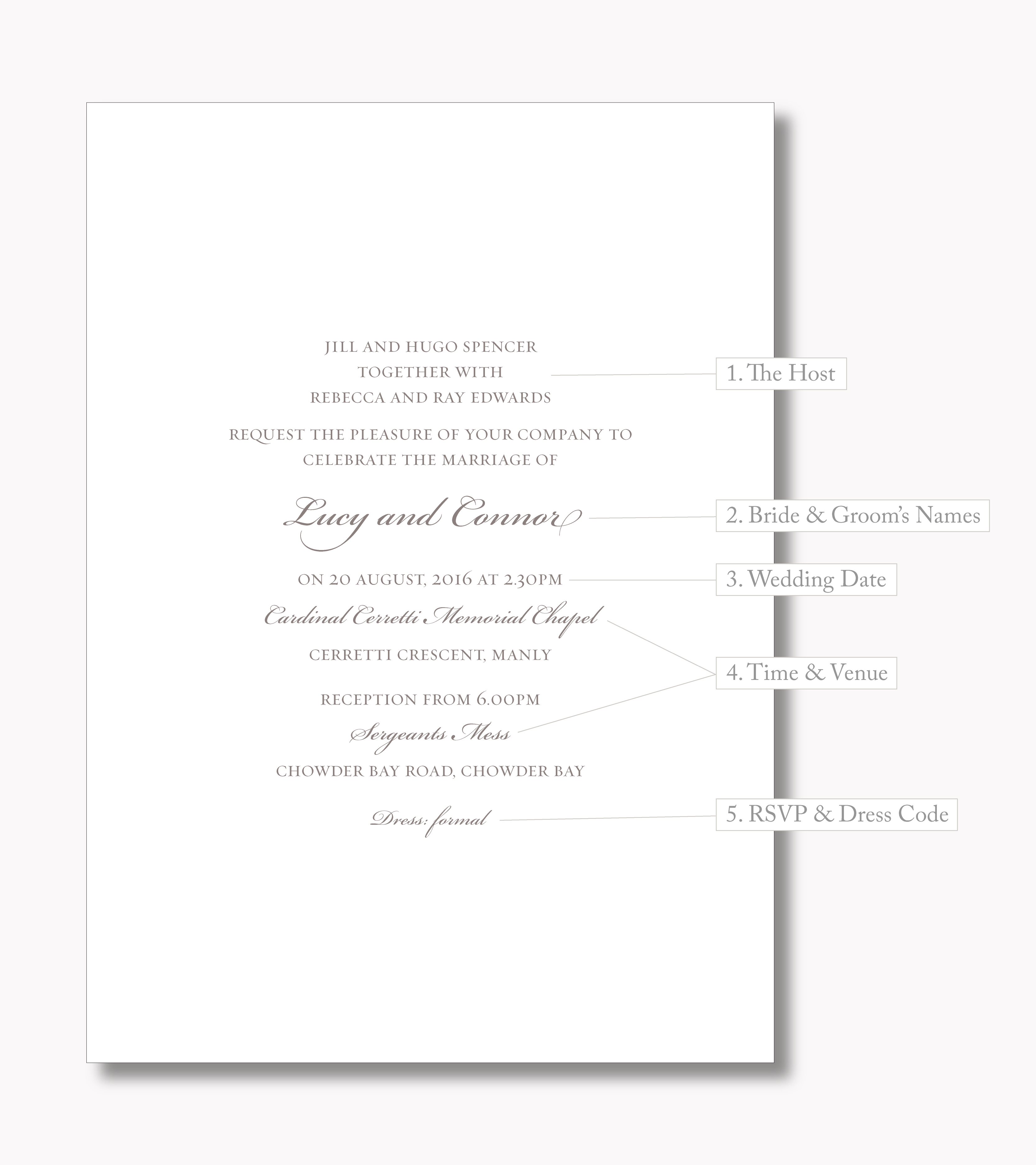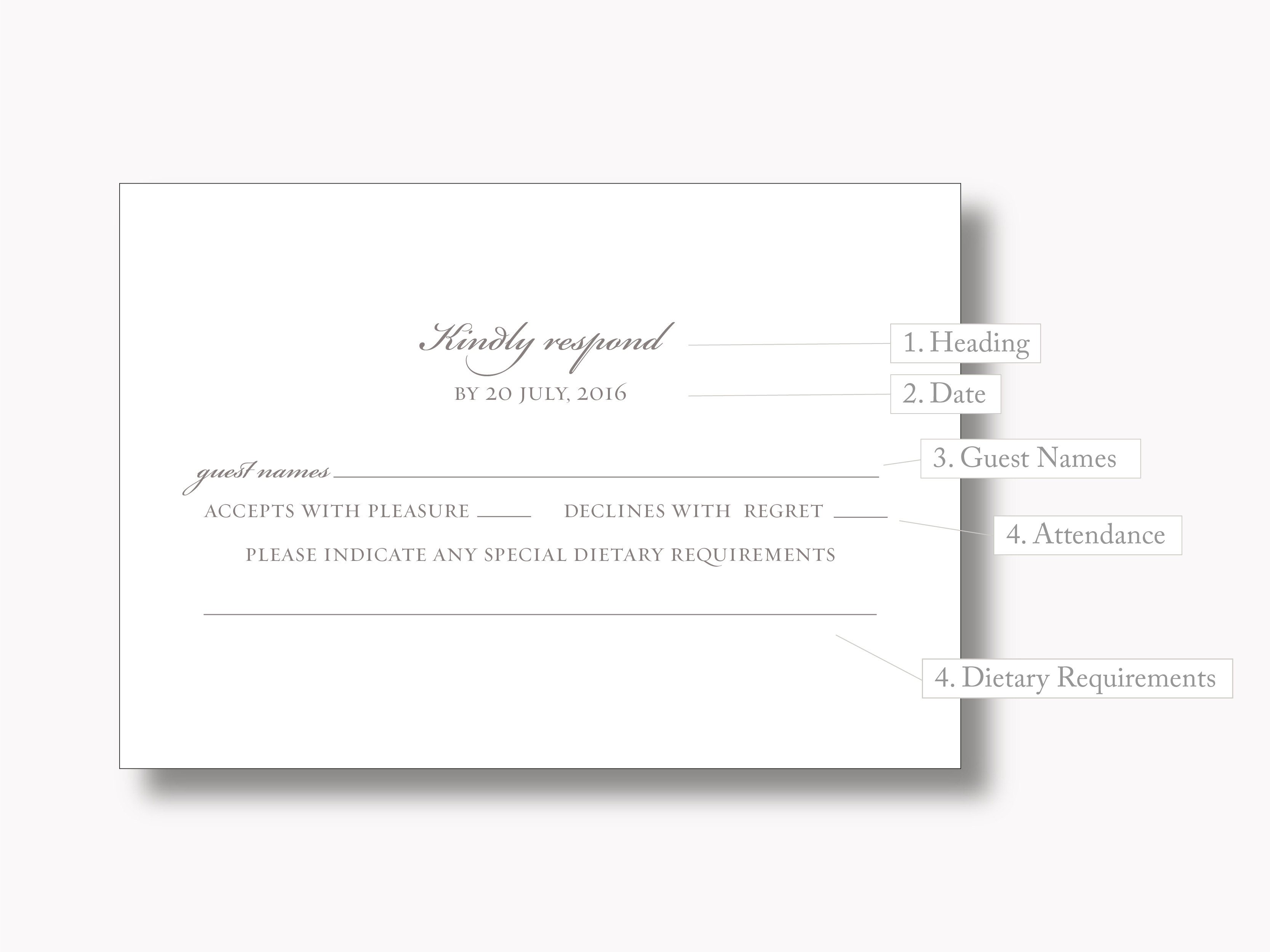Australian Wedding Invitation Etiquette
Wedding invitation etiquette in Australia is slightly different from other parts of the world. Here we share some of our experience regarding etiquette for designing and creating wedding invitations in Australia. This includes our best tips for structuring your invitation wording and how to word your RSVP card.
Wedding Invitation Wording Etiquette
Here's an example Invitation from our Lucy suite highlighting the different components that make up the Invitation wording.

1. The Host
Normally your invitation will begin by listing the host(s) and inviting your guests. If the Bride and Groom are hosting, their names can be listed first, followed by the invitational lines. In Australia, we see a mix of different wording used for the host, depending on how formal the couple wishes their invitations to be. It is common to use prefixes of Mr & Mrs for the parent's names. See more examples of how to structure and write the Host in our Wedding Invitation Wording article.
2. The Bride and Groom’s Names
It is traditional to include both the first and middle names of the bride and groom on the wedding invitation. However, many couples choose to omit the middle and/or last names, and this is acceptable in contemporary Australian wedding etiquette. Nowadays only the most formal of invitations include the bride and grooms' middle names.
3. Wedding Date
Note that in Australia the date is written differently to the USA. Normally the day of the week is listed first, followed by the date of the month and then the month itself (e.g. Saturday, fourth of June 2018). It is also common to use numerals for the date and this is acceptable in contemporary Australian wedding etiquette (and often easier for guests to read).
4. Time & Venue
This is where you detail your wedding location along with your starting times.
Times can be written as numerals or written out in full. If writing the time of day in full, you may also like to include the time of day (e.g. “Saturday afternoon”). Within Australia, afternoon begins at twelve o'clock, and evening starts at six o'clock.
It is standard in Australia that both the ceremony and reception venues will be listed on the invitation, as opposed to having a separate 'reception' card (which is usual in the USA). Guests invited to a wedding in Australia are expected to attend both the ceremony and reception.
In Australia, it is expected that the full or partial venue street address will be included on the invitation. This is different to the USA where including these details is not recommended. Including the state and postcode is optional, but expect to include at least a partial street address for your guests.
5. RSVP & Dress Code
When a response is required and a response card is not being used, this information can be included on the invitation. A date, contact name, contact address or contact number can be listed. Alternatively, guests can respond in writing to the return address. Email addresses are also becoming more common, and are acceptable on invitations in Australia.
Dress code is not essential but can be useful in letting your guests know the style of your wedding day. Some example dress codes include: Black tie, Lounge Suit, Semi-formal, Cocktail and Smart Casual. See more examples of dress codes and how to word them in our Dress Codes article.
Response Card Wording Etiquette
Here's an example Response Card from our Lucy suite highlighting the different components that make up the wording. Find more examples and formats on our Response Cards article.

1. Heading
Common headings for the RSVP card in Australia include:
Kindly Reply / Respond
Please Reply / Respond
The favour of your Reply / Response
RSVP
Note that while 'Please RSVP' might sound like a nice combination, it is really saying 'Please' twice - RSVP is an abbreviation of the French Répondez s'il vous plaît, meaning “Please respond”.
2. RSVP Date
In general, the RSVP date would be around 1 month before your wedding. This really depends on your Venue as well and how much notice you need to give regarding final numbers. Expect to have to chase a few final RSVP's and allow yourselves a week for this (and any late replies in the mail).
3. Guest Names
Normally this is where you allow a space for guests to write their full names. In the USA, it is common for this to be styled as an 'M….' which would then be completed by the guests with the rest of their prefix and full name. In Australia, this would be a highly unusual way to format a Response card! We recommend using the following wording as examples:
Guest names:
Guest name/s:
Name/s:
4. Acceptance
This is where you ask your guests to provide an answer - can they attend? There are many, many ways to word this but generally 'Accepts with Pleasure' or 'Declines with Regret' is the standard wording used within Australia. A tick box or line is usually used for the purpose.
5. Dietary Requirements
As allergies and intolerances have become more prevalent it has become more important to include a space for guests to list these in their reply. While small icons might be cute (think a carrot for vegetarians, a wheat head for gluten-free), we recommend the simpler option of allowing a space for guests to list any dietary requirements. Dietary requirements are more complex and nuanced than simple icons can represent, and guests with any special concerns will appreciate that you've considered them in the design of your card.
Other information
While the response areas above are the standard minimum requirement for wedding invitations in Australia, you can add more reply fields to your cards if needed. These can include essential information such as transport requirements or other events, or fun inclusions such as song requests.
Invitation Envelope Wording Etiquette
Addressing your invitation envelopes can be tricky, but the best approach is always to use the name format that you feel comfortable with in relation to your guests. I also recommend being consistent with the style (e.g. either applying all titles or no titles), however, this isn't always practical so use your discretion. In Australia, titles are traditional, but we also recommend no titles for less-formal events.
Some Examples of formatting
Married Couple
Mr. John and Mrs. Sophia Smith
or
Mr. and Mrs. Smith
or
John and Sophia Smith
Married Couple with Different Last Names
Mr. John Smith and Mrs. Sophia Devine
or
John Smith and Sophia Devine
Unmarried Couple Living Together
Mr. John Smith
Ms. Sophia Devine
or
John Smith
Sophia Devine
(On separate lines)
Same-Sex Couple
Ms. Jennifer Watson and Ms. Julia Moray
or
Jennifer Watson and Julia Moray
(Alphabetical order, or whomever is the closest acquaintance.)
Families
The shortest wording option is to include the parents' names and “and Family” afterwards.
Mr. John and Mrs. Sophia Smith and Family
or
Mr. and Mrs. Smith and Family
or
John and Sophia Smith and family
For girls under 18, use the prefix 'Miss', for boys under 18 no title is needed.
Children 18 and Older
If children 18 and older do not live with their parents, they should receive their own invitations.
Ms. Sarah Smith
or
Sarah Smith
Married Doctors
Doctors Jennifer and Thomas Smith
or
Dr. Jennifer and Mr. Thomas Smith
or
Dr. Thomas and Mrs. Jennifer Smith
We’ve included the most common circumstances that we’ve come across, but please get in touch if you need additional advice. We also have an Excel document that you can use to compile your delivery address list and / or name band list. Download the free Envelope Delivery Address template or the combined Envelope & Name band template.
More wording suggestions and examples
For more ideas and examples be sure to read our other articles on wording:
Save the Date Wording
Wording 'Adults Only' Wedding Invitations
Addressing your Wedding Invitations
Gift Card Wording
Thank You Card Wording
You can read more about wording for your pieces as well as download PDF examples and suggestions on our Wording & Etiquette page. Be sure to browse our Collection for examples and ideas as well.
Our wedding collection designs showcase many possibilities and examples of designs for the Australian context. Contact us if you need more advice or suggestions for wording your wedding invitations - we are more than happy to help!

